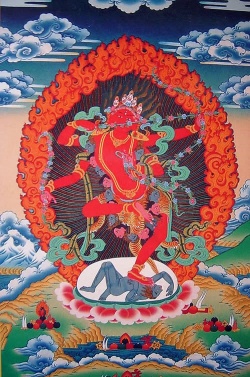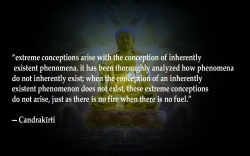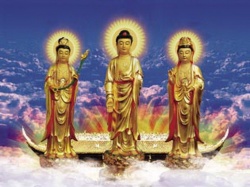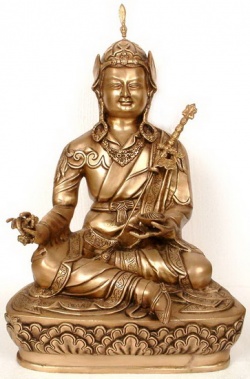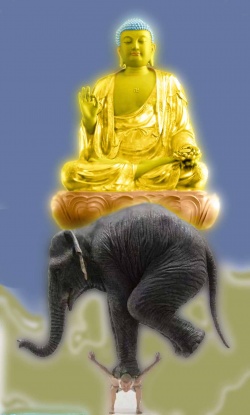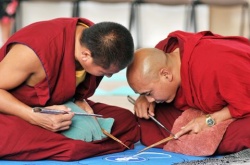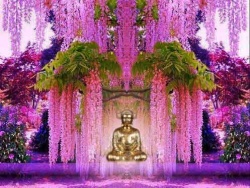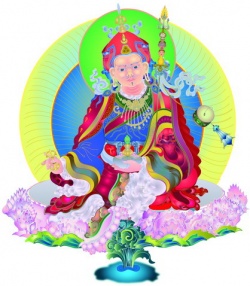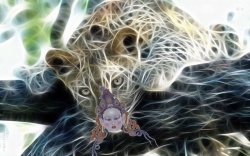Buddhism and the Tale of Genji 源氏物語
Buddhism and the Tale of Genji 源氏物語
By Indrajala (Jeffrey Kotyk)
Considering the culture and times that Murasaki Shikibu lived in, one might ask to what degree did Buddhist thought influence her writing of fiction? Kato makes the following claim: “Buddhism provides the philosophical background to The Tale of Genji”.[1] This is by no means axiomatic and the modern reader might be initially perplexed when they consider the myriad interpretations and literary dissections the tale has been subjected to over the course of ten centuries by numerous schools of thought. Akiyama notes that at the end of the Heian period there were various interpretations of the Genji from a Buddhist perspective, but from the end of the Kamakura period a Confucian view was propagated which ultimately was to be dismissed along with the Buddhist view by Kokugaku scholars such as Moto’ori Norinaga in the Edo period who focused on mono no aware as a kind of literary and moral value liberated from both Confucian and Buddhist models.[2]
This reveals to us that the Genji was by no means universally interpreted in the same light, much less did everyone ever agree that it was based on Buddhist philosophy. Some Buddhists even rejected the tale. Hence, for someone to outright declare that the work is based on Buddhist philosophy requires not only justification, but also evidence to make such an argument. Upon examination of such evidence the truth of the original claim will be validated, but before that one should examine the alternative views which challenge the claim. I assert that Kato’s claim is accurate and that a Buddhist reading of the Genji is not only suitable, but that Murasaki Shikibu wrote it from a Buddhist perspective.
There were indeed readings that did not see the tale in a Buddhist light. Some Neo-Confucians for example saw the tale as something entirely else. Kumazawa Banzan (1619-1691), a neo-Confucian scholar, in his work Genji Gaiden (ca. 1673) painted the tale as a kind of storehouse of Confucian virtue not unlike the classical Chinese texts which idealized and glorified China’s ancient past. He objected to annotation which touched on immoral acts found within the tale seeing these as deviations from what he perceived to be Murasaki Shikibu’s original intention. Caddeau notes it “provides us with a clear picture of Banzan’s understanding of Confucianism at the time,” but justifiably describes it as “a highly subjective view of Genji.”[3] Banzan’s work does in a sense reflect the Confucian elements, scarce as they are that are present within the text. Kato does indeed acknowledge the Confucian elements. He notes, “Naturally, the influence of Confucian morality can also be detected but it is by no means as noticeable as in the case of the Tale of Ochikubo and very sparse indeed compared with The Tale of the Hollow Tree.”[4] While the Confucian elements are there, it would hardly warrant declaring the tale a storehouse of Confucian virtue and thus Caddeau’s assertion of it being a highly subjective view is most appropriate. If one merely acknowledges the scarcity of Confucian ideas and elements within the Tale of Genji, it is clear that any attempt to label it as a source or representation of Confucianism is really untenable and just simple idealization. If anything, the tale is a depository of thoughts and ideas on Buddhist ideas that survive in the form of fiction. This will be discussed later.
As noted above it was not only Confucians who saw the Genji in a different light, but also the Kokugaku scholars of which Moto’ori Norinaga was most notable as he insisted that the Genji not be read as any kind of moral parable, but rather to be read as mono no aware or a kind of “native aesthetic that transcends the notion of good and evil” and going so far as to dismiss Confucian and Buddhist readings as foreign values.[5] This brings into question how he is able to make such a claim when such an enormous amount of Buddhist ideas and practices are described throughout the tale. Shirane notes that
- “his extreme reaction to ‘foreign’ elements led him to distort the text, particularly those sections with Buddhistic overtones. Norinaga ignores critical passages – such as the one in which Genji reacts to the birth of Kaoru – where characters reflect on their sukuse, or Buddhistic sense of fate.”[6]
Norinaga’s dismissal of Buddhist readings leads one to conclude his analysis was a bit too distorted to really be taken seriously. His reading might be useful in understanding how certain members of Edo Period Japan viewed the tale, but he ignores too much obvious proof that would refute his dismissal of Buddhist readings of the tale and thus one can conclude he was reading too much into the tale for his own purposes.
After examining some claims and ideas of Confucianists and Kokugaku scholars regarding the tale we are left with one last major school of thought: the Buddhists. At this point the potential validity of Kato’s claim should start to become evident. How could one really know if Murasaki Shikibu was writing the tale from a Buddhist perspective or not? Is there ample evidence to suggest that the Tale of Genji was based on Buddhist philosophy?
Before we proceed into the details of Buddhist elements within the text we should address the fact that not all Buddhists viewed the tale in a positive light and many viewed it as a worthless piece of fiction that earned Murasaki Shikibu as place in the hell realms for writing such a work which then sparked Genji Kuyō (源氏供養) or popular prayers for the salvation of Murasaki Shikibu.[7] It is clear that some Buddhists initially saw the tale in a very negative light. The readership initially was primarily women and not men, and given the length of the entire work it makes one wonder: did those who wrote the tale off as a sinful piece of literature, which were men and not women, actually read all the chapters, or did they merely hear about the amorous elements women readers were enjoying at the time and instantly declare such a work as evil? Regardless of the assertions claiming Murasaki Shikibu fell into the hell realms for composing a work with somewhat amorous elements, it is clear that while the tale itself is far from being a Buddhist narrative or hōbensetsu (方便説) there is an enormous Buddhist influence on the Tale of Genji on the whole which likely reflects the author’s own spiritual inclinations. This will now be demonstrated.
Shirane asserts that Murasaki Shikibu did not attempt to demonstrate the Four Noble Truths (四諦).[8] This point is debateable. For example, according to orthodox Buddhist thought the first noble truth (苦諦) is that conditioned existence, that is to say imperfect habitual existence arising from ignorance, is suffering and that there are three types of suffering(三苦) which include the suffering of suffering (苦苦), suffering of change (壊苦) and all pervasive suffering (行苦). [9] Genji’s life especially typifies the second. For example, Genji suffers the loss of his mother, but eventually obtains the object of his desire through Fujitsubō only to be temporarily satisfied until the desired object is made unavailable. Dissatisfied and suffering, he seeks a new substitute which becomes Murasaki.
Later, Genji rises from exile in Suma to be one of the most powerful men in the capital owning the massive Rokujō-in and complimented by a harem of beautiful noblewomen. However, his cherished Murasaki falls ill and eventually when that which was the object of sensual and psychological pleasures ceases to exist Genji suffers immensely. In The Wizard chapter Genji is portrayed as utterly lost and constantly reflecting on his lost beloved who once brought him great joy and happiness. His attachment to impermanent objects has given rise to his long depression that lasts past the first annual memorial following Murasaki’s death. Indeed, this clearly illustrates the suffering of change and perhaps Murasaki Shikibu had this in mind. At the very least one has enough evidence to make the case that these events reflect, whether intentional or not, Buddhist ideas and that considering the author’s background and education it may have been no coincidence.
Another point worth mentioning is the numerous references and allusions to rebirth that one finds within the tale. It is on the first page of the first chapter we have reference to past lives: “It may have been because of a bond in a former life that she bore the emperor a beautiful son, a jewel beyond compare.”[10] This is especially striking as it illustrates the Buddhist ideas present within the text are not subtle, but superficially apparent from the very beginning of the text. If Murasaki Shikibu did write the chapters in sequence chronologically then it would be relevant to point out that in the earliest parts of the tale she is making references to past lives or reincarnation, which is most certainly a Buddhist belief and not an indigenous one.
Although a number of Buddhas make appearances throughout the tale, the most common is Amida (阿弥陀) with twelve examples in total, which may as Sasakawa asserts be a result of the rising prominence of Pureland beliefs in this period which correspond to various popular works such as Nihon Ōjō Kyokuraku Ki (日本往生極楽記) and Genshin’s Ōjōyōshū (往生要集).[11] We also see twenty examples of the nenbutsu (念仏) being practiced throughout the tale.[12] This definitely indicates that both faith in Amida and the practice of nenbutsu was at the very least on the mind of Murasaki Shikibu. It might be inappropriate to declare the author to have been a devout practitioner of Pureland Buddhism, striking though the religious elements become as the tale progresses, but at the very least we need to recognize that from the earliest chapters up until the very end of the tale – this likely spanning a good part of the author’s adult life – we see plenty of examples of characters expressing their faith in salvation through Amida and practicing the nenbutsu not only for themselves, but also for their departed loved ones.
From the mid-Heian period onward the trend was from Mikkyō to Pureland teachings.[13] There exists references within the tale to both esoteric Tendai and Shingon practices. For example, there are two references in total to Vairocana or Dainichi (毘盧遮那・大日如来) compared to the twenty two references to Amida, which according to Sasakawa may indicate the decay of the esoteric and the rise of Pureland teachings.[14] One other possible explanation is simply that Murasaki Shikibu did not have ready access to esoteric teachings because it was almost exclusively the realm of ordained male monastics and that Pureland teachings were simply more accessible. Nevertheless, throughout the tale various characters practice kaji (加持) to cure their ailments (除病) a total of twenty five times.[15] This perhaps indicates just how popular such a practice was in Murasaki Shikibu’s time and perhaps even says something about her own personal inclinations toward such a practice. What is kaji? Yamasaki defines it as such: “When the three secrects (body, speech and mind) of the esoteric practitioner unite with the Universal Three Secrets, both are said to be energized in a process, called mutual empowerment (kaji), that makes their union real.”[16] Essentially this is a merging of an individual practitioner with the dharmakaya which is personified by Dainichi Nyorai. One might suggest that Murasaki Shikibu saw this practice as having curative efficacy and as a result we see this practice mentioned twenty five times. Again, the certain and abundant Buddhist influence is clear.
Besides Amida and Vairocana, there are three other prominent Buddhist figures that appear in the tale. The first of which is the Bodhisattva Maitreya (弥勒菩薩), who is said to be the future Buddha who will descend from Tuṣita Heaven (兜率天) 5,670,000,000 years after Buddha Shakyamuni’s death.[17] There is reference made to him in a devotional prayer that young Genji overhears at dawn from a devotee beyond the estate’s wall:
- "Dawn approached. No cocks were crowing. There was only the voice of an old man making deep obeisance to a Buddha, in preparation, it would seem, for a pilgrimage to Mitake. He seemed to be prostrating himself repeatedly and with much difficulty. All very sad. In a life itself like the morning dew, what could he desire so earnestly?"
- "Praise to the Messiah to come," intoned the voice.
Later on in the chapter following Yūgao’s funeral, Koremitsu makes supplication to Kannon of Kiyomizu (清水の観音):
- "Koremitsu was in a panic. He should not have permitted this expedition, however strong Genji's wishes. Dipping his hands in the river, he turned and made supplication to Kiyomizu. Genji somehow pulled himself together. Silently invoking the holy name, he was seen back to Nijo."[19]
We should note here that Seidensticker translates Kannon (観音) as “the holy name”. The original line in Japanese being: “いと心あわたゝしければ、川の水に手を洗ひて、清水の観音を念じ.”[20] We can see in the original that the Bodhisattva Kannon is mentioned by name rather than pseudonym.
Finally, the Medicine Buddha practice is also referred to in the “New Herbs” chapter (薬師仏供養), which Sasakawa notes as a significant practice aimed at worldly benefits that was quite strong alongside faith in Kannon in Murasaki Shikibu’s time.[21]
At this point we should again review the dichotomy Katō draws concerning Buddhist practices in the tale:
- "There are two aspects of the role played by Buddhism – a this-wordly expectation of magical efficacy of Buddhist ceremonies and a desire for salvation in the next work. The first of these stems from traditional, conventionalized and institutionalized practices from earlier court society, the second from the influence of Pure Land Buddhism."[22]
The first aspect as noted above would certainly reflect the Medicine Buddha practice as we see in the New Herbs and elsewhere – in particular the esoteric rituals described above that were thought to be able to cure ailments. On the reverse, the other-worldly aspects would best be represented by the numerous examples of nenbutsu and faith in Amida, which were generally aimed at securing good fortune post-mortem either for oneself or for a departed loved one, or ideally to be reborn in the Pureland.
We might suggest, almost like Kumazawa Banzan, that the tale is a storehouse of Buddhist ideas and practices from the Heian period. Indeed the tale may be fiction, but it does reflect the common ideas, practices and views of the time. The Heian period aristocracy was generally quite familiar with and a certain segment evidently was quite devoted to Buddhism of one form or another. It was essentially a part of everyday life. The reader is able through Murasaki Shikibu’s work to gain an idea of how Buddhism was perceived and practiced by the upper echelons of Heian society. This is not to say that the Tale of Genji is a hōbensetsu (方便説) or Buddhist parable written by a manifest Bodhisattva – but rather the tale is so heavily drenched in Buddhist ideas and imagery as to make it justified, if not appropriate, to assert as Katō does that the tale is based on Buddhist philosophy. The evidence is overwhelming enough to bring into serious question alternative claims like those of the Neo-Confucianists and especially the later Kokugaku scholars.
Footnotes
- ↑ Shuichi Kato, A History of Japanese Literature From the Man’Yōshū to Modern Times, Translated by Don Sanderson (Surrey: Japan Library, 1997), 74.
- ↑ Ken Akiyama 秋山虔, “Genjimonogatari no Sekai 源氏物語の世界,” in Nihon Bungaku Shinshi Kodai II 日本文学新史〈古代Ⅱ〉, ed. Kazuo Suzuki (Tōkyō: Shibundō 至文堂, 1990), 182-183.
- ↑ Patrick Caddeau, Appraising Genji: literary criticism and cultural anxiety in the age of the last samurai (Albany, NY: State University of NewYork Press, 2006), 22.
- ↑ Shuichi Kato, A History of Japanese Literature From the Man’Yōshū to Modern Times,
Translated by Don Sanderson (Surrey: Japan Library, 1997), 74. - ↑ Haruo Shirane, The Bridge of Dreams A Poetics of ‘The Tale of Genji’ (Stanford, CA: Stanford University Press, 1987), 175.
- ↑ Ibid., 177.
- ↑ Haruo Shirane, “The Tale of Genji and the Dynamics of Cultural Production.” In Envisioning the Tale of Genji: media, gender, and cultural production, ed. Haruo Shirane (New York: Columbia University Press: 2008), 18.
- ↑ Haruo Shirane, The Bridge of Dreams A Poetics of ‘The Tale of Genji’ (Stanford, CA: Stanford University Press, 1987), 178.
- ↑ 佛學小辭典, 陳義孝居士編 (台北市: 方廣文化, 1999) 118.
- ↑ Murasaki Shikibu, The Tale of Genji, trans. Edward G. Seidensticker (New York: Alfred A. Knope, 1976), 3-4.
- ↑ Hiroshi Sasakawa 笹川博司. “Bukkyō no Shisō 仏教思想.” In Kōza Genji Monogatari Kenkyū Dainiken Genjimonogatari to Sono Jidai 講座源氏物語研究第二巻 源氏物語とその時代, ed. Ī Haruki伊井春樹 and Kanō Shigefumi加納重文 (Tōkyō: Ōfū おうふう, 2006), 144
- ↑ Ibid., 146-147.
- ↑ Ibid., 143.
- ↑ Ibid., 151.
- ↑ Ibid., 155.
- ↑ Taikō Yamasaki, Shingon Japanese Esoteric Buddhism, trans. Richard and Cynthia Peterson (Boston: Shambala, 1988), 70.
- ↑ Hiroshi Sasakawa 笹川博司. “Bukkyō no Shisō 仏教思想.” In Kōza Genji Monogatari Kenkyū Dainiken Genjimonogatari to Sono Jidai 講座源氏物語研究第二巻 源氏物語とその時代, ed. Ī Haruki伊井春樹 and Kanō Shigefumi加納重文 (Tōkyō: Ōfū おうふう, 2006), 160.
- ↑ Murasaki Shikibu, The Tale of Genji, trans. Edward G. Seidensticker (New York: Alfred A. Knope, 1976), 68.
- ↑ Ibid., 77.
- ↑ Quoted in Hiroshi Sasakawa 笹川博司. “Bukkyō no Shisō 仏教思想.” In Kōza Genji Monogatari Kenkyū Dainiken Genjimonogatari to Sono Jidai 講座源氏物語研究第二巻 源氏物語とその時代, ed. Ī Haruki伊井春樹 and Kanō Shigefumi加納重文 (Tōkyō: Ōfū おうふう, 2006), 161.
- ↑ Ibid., 164.
- ↑ Shuichi Kato, A History of Japanese Literature From the Man’Yōshū to Modern Times, Translated by Don Sanderson (Surrey: Japan Library, 1997), 75
